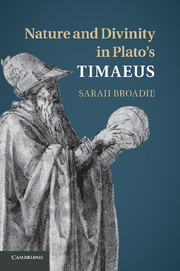Book contents
- Frontmatter
- Contents
- Acknowledgements
- What lies ahead
- Chapter 1 The separateness of the Demiurge
- Chapter 2 Paradigms and epistemic possibilities
- Chapter 3 The metaphysics of the paradigm
- Chapter 4 Immortal intellect under mortal conditions
- Chapter 5 The Timaeus–Critias complex
- Chapter 6 The genesis of the four elements
- Chapter 7 Divine and natural causation
- In conclusion
- Appendix on ‘parts of the paradigm’
- References
- General index
- Index locorum
Appendix on ‘parts of the paradigm’
Published online by Cambridge University Press: 05 December 2011
- Frontmatter
- Contents
- Acknowledgements
- What lies ahead
- Chapter 1 The separateness of the Demiurge
- Chapter 2 Paradigms and epistemic possibilities
- Chapter 3 The metaphysics of the paradigm
- Chapter 4 Immortal intellect under mortal conditions
- Chapter 5 The Timaeus–Critias complex
- Chapter 6 The genesis of the four elements
- Chapter 7 Divine and natural causation
- In conclusion
- Appendix on ‘parts of the paradigm’
- References
- General index
- Index locorum
Summary
In Chapter 3, section 3.4, I used the phrase ‘a part of the paradigm’ (referring to the Demiurge’s paradigm). The phrase is a term of art, and I used it first in connection with (1) an intelligible content such that divine demiurgy produces a generated object that accords with it. Then later in the section I used it in connection with (2) an intelligible content that depends on human activity for implementation in the realm of genesis, but which is present to the Demiurge in that his world-making deliberately allows for such human implementations. Thus in terms of (2) an intelligible I is ‘part of’ the paradigm without being such that divine demiurgy produces objects that accord with I. Now, there is, presumably, a further way in which some intelligibles are ‘parts of’ or ‘in’ the cosmic paradigm without being such that divine demiurgy produces objects that accord with them. This would be (3) the way in which Forms of the materials used by the Demiurge to construct the cosmos are ‘in’ the cosmic paradigm. For the materials are not part of what he produces, yet he obviously produces with an eye to their Forms, these being the intelligible natures of the materials used. Similarly, formulae of the ingredients for a stew are ‘in’ the stew-recipe, but not in such a way as to be sub-recipes for producing parts of the whole that the stew-recipe is a recipe for. For example, a formula for flour is ‘in’ the recipe for beef and dumpling stew but not in it as a sub-recipe; an example of the latter would be the recipe for the dumplings. So the recipe for beef and dumpling stew, a practical quiddity (cf. Chapter 3, section 3.2) (a) tells us what to make if making that type of dish, (b) features (or presupposes) a formula for flour, but (c) does not tell us what to make if someone wanted to make flour. Now, returning to the Demiurge, the phrase ‘intelligible world’, with which Chapter 3 opened, can generate confusion. Commentators who speak of Plato’s ‘two-worlds’ metaphysics, especially in the context of the central books of the Republic and Parmenides Part i, sometimes use ‘intelligible world’ to mean the whole gamut of intelligibles, this being contrasted with the totality of sensibles. In this sense, it is a tautology that all intelligibles are members of the intelligible world and members of it in the same way, since all that this means is that it is true of each of them that it is an intelligible and not a sensible object. But moving to the Timaeus, one can, unfortunately, confuse ‘intelligible world’ in this sense with the Demiurge’s paradigm. (For just as we might call the Form of human being ‘intelligible Human Being’, so we might call the Form or intelligible paradigm of the [demiurgically organised] world [i.e. the kosmos] ‘intelligible World’.) It can then seem as if the Demiurge’s paradigm contains or features every intelligible (or every cosmological one) in the same way; i.e. it is as if the difference between (1) and (3) above has disappeared. It can then seem as if Plato is committed to the doctrine that demiurgic implementation of the world-paradigm consists in the production, in the sphere of genesis, of the organised cosmos and its materials. (Thus the Demiurge does not in fact ‘take over’ materials that were already around, as said at 30a4; cf. 68e3.) This wholesale way of looking at the transition from eternal-intelligible to generated-sensible, obliterates any difference – crystal clear in the text – between Plato’s first and second cosmological beginnings, i.e. between (i) the transition from unformed pre-existing materials to the organised cosmos, and (ii) the prior genesis of those materials themselves. (In one of the two accounts of the genesis of the materials, God is involved, but in this role he is not called ‘Demiurge’, since demiurgy as such is responsible for the transition from materials to cosmos.) It is now as if there is only one beginning, at which all cosmological Forms without distinction are relevant all at once, so to speak. Erasure of the difference between the two beginnings (or claiming that it is merely presentational) is a feature of the sempiternalist interpretation discussed in Chapter 7. It is also a feature of the ontological interpretation of the Receptacle: see Chapter 6, especially section 6.5. There may be secure reasons for preferring either or both of these interpretations, but the glide of thought just outlined is surely not one of them.
- Type
- Chapter
- Information
- Nature and Divinity in Plato's Timaeus , pp. 284 - 285Publisher: Cambridge University PressPrint publication year: 2011



